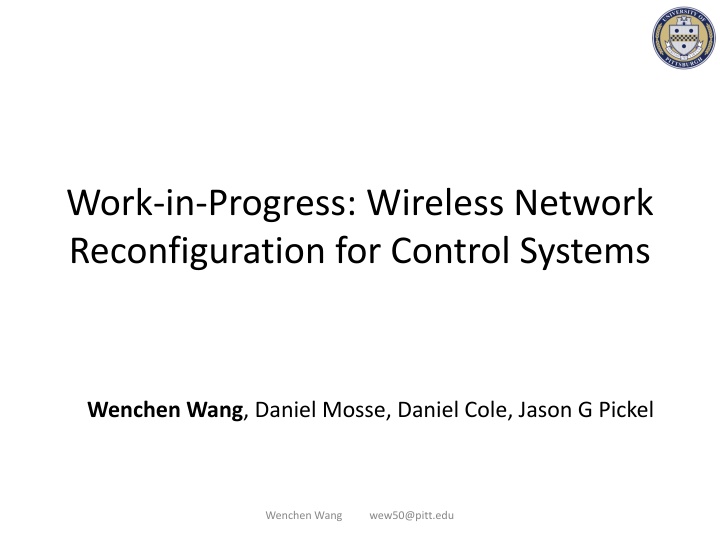
Wireless Network Reconfiguration for Control Systems
Explore the work-in-progress on wireless network reconfiguration for control systems, addressing issues such as delay, message loss, and network-induced errors to enhance remote controller performance and reduce errors. The research focuses on optimizing network configuration to balance delivery ratio and delay, offering a framework for network reconfiguration and real-time scheduling in wireless control systems. Motivations include addressing power demands in Multiple Small Modular Reactors (SMRs) and testing network-induced errors under varying power change scenarios.
Download Presentation

Please find below an Image/Link to download the presentation.
The content on the website is provided AS IS for your information and personal use only. It may not be sold, licensed, or shared on other websites without obtaining consent from the author. If you encounter any issues during the download, it is possible that the publisher has removed the file from their server.
You are allowed to download the files provided on this website for personal or commercial use, subject to the condition that they are used lawfully. All files are the property of their respective owners.
The content on the website is provided AS IS for your information and personal use only. It may not be sold, licensed, or shared on other websites without obtaining consent from the author.
E N D
Presentation Transcript
Work-in-Progress: Wireless Network Reconfiguration for Control Systems Wenchen Wang, Daniel Mosse, Daniel Cole, Jason G Pickel Wenchen Wang wew50@pitt.edu
Wireless Control System (WCS) Actuator Plant Sensors Delay and Message Loss measurements control signal Remote Controller Performance Degradation Delay and message losses can induce additional error, network-induced error Wired control system output output Network-induced error Wireless control system output time Wenchen Wang wew50@pitt.edu
Problem Statement Trade-off between delivery ratio and delay Higher delivery ratio more redundant nodes more delay Optimal network configuration Time-correlated link failures [Baccour TOSN 12] Network reconfiguration Objective: network-induced error reduction Solution: network reconfiguration framework Wenchen Wang wew50@pitt.edu
Network Reconfiguration Framework Input Network configuration set Offline Optimal network configuration table indexed by LSR values. Online LSR estimation at run time Centralized network reconfiguration algorithm Wenchen Wang wew50@pitt.edu
Thanks! Wenchen Wang wew50@pitt.edu
Work-in-Progress: Cross-layer Real- Time Scheduling for Wireless Control System Wenchen Wang, Daniel Mosse, Jason G Pickel, Daniel Cole Wenchen Wang wew50@pitt.edu
Motivation: NPP demands Multiple Small Modular Reactors (SMRs) in an NPP Different SMRs typically have different power demands Power demands change dynamically, given load consumed Wenchen Wang wew50@pitt.edu
Motivation: observations Test the network-induced error on one PHX Different reference functions with one ramp power change amount (PCA) power change duration (PCD) Different delivery ratio and delay Ramp30 PCA: 10 MW PCD: 30s Wenchen Wang wew50@pitt.edu
Motivation: observations Network-induced error 1 Power output RMSE 0.8 delay=0.1s 0.6 delay=0.2s 0.4 delay=0.3s RMSEs are similar delay=0.4s 0.2 delay=0.5s 0 15 30 45 60 75 90 105 120 PCD (s) PCA: 10 MW; DR: 0.9 For reference functions with higher ramp ratios, the network delay becomes a more significant factor. Wenchen Wang wew50@pitt.edu
Our Solution Objective Reduce total network-induced error for multiple control systems Cross-layer real-time scheduling Inject the application demands into the network layer to change measurement deadlines dynamically Assign smaller deadlines for more urgent application demands Offline control system analysis Wenchen Wang wew50@pitt.edu
Thanks! Wenchen Wang wew50@pitt.edu
Backup slides Wenchen Wang wew50@pitt.edu
Motivation: NPP demands Multiple Small Modular Reactors (SMRs) in an NPP Do you need this slide? Or the next one is sufficient? Wenchen Wang wew50@pitt.edu
Motivation: Observations For reference functions with shorter PCDs, the network delay becomes a more significant factor. 1 Power output RMSE 0.8 delay=0.1s 0.6 delay=0.2s RMSEs are similar 0.4 delay=0.3s 0.2 delay=0.4s 0 delay=0.5s 15 30 45 60 75 90 105 120 PCD (s) PCA: 10 MW; DR: 0.9 For reference functions with higher PCAs, the network delay becomes more significant factor. 0.7 Power output RMSE 0.6 0.5 delay=0.1s 0.4 delay=0.2s RMSEs are similar 0.3 delay=0.3s 0.2 0.1 delay=0.4s 0 delay=0.5s 10 8 6 4 2 PCA (MW) PCD: 30s; DR: 0.9 Wenchen Wang wew50@pitt.edu
Motivation: observations 1 Delay has more significant effect on the control system performance Power output RMSE 0.8 delay=0.1s 0.6 delay=0.2s 0.4 delay=0.3s 0.2 delay=0.4s 0 delay=0.5s 0.9 0.8 0.7 0.6 0.5 Delivery ratio PCD: 30s; PCA: 10MW Set a deadline according to the application demands Small deadline for reference functions with less PCD or more aggressive PCA Cross-layer dynamic schedule the network flows Wenchen Wang wew50@pitt.edu
Problem Statement Network flow A set of end-to-end network flows associates with one source , a destination , a period , and a deadline, Control systems application demands Control systems have different reference functions with multiple ramps PHX1 PHX2 Required Power time ?5 ?0 ?2 ?3?4 ?1 Objective: reduce total network-induced errors for multiple control systems: Wenchen Wang wew50@pitt.edu




